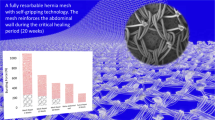The aim of this study was to compare the efficacy of different methods of sutureless fixation of lightweight meshes made of different polymers for repair of experimental hernias. Two lateral hernia defects were modeled in male rats and covered with polyester and polypropylene prostheses. The meshes were fixed with Histacryl glue (group 1), or self-gripping meshes were used (group 2), or the meshes were implanted without fixation (group 3). On day 5 after surgery, mesh position and efficiency of fixation were evaluated. It was found that fixation is necessary for all light surgical meshes. Polyester meshes demonstrated better adhesive properties than polypropylene meshes. The most pronounced differences in the adhesive properties were found for self-gripping prosthesis, while in the groups with glue fixation, the differences were less pronounced.
Similar content being viewed by others
References
Galimov OV, Khanov VO, Shkundin AV, Gaptrakipov EH, Fattakhov RF. The use of different methods of fixation implants in an experiment on laboratory animals. Fundamental. Issled. 2011;(11-2):281-283. Russian.
Anurov MV, Titkova SM, Oettinger AP. Comparison of the results of hernia defect plasty with standard and light surgical meshes with identical knitted structure. Bull. Exp. Biol. Med. 2011;150(4):459-464.
Beattie GC, Kumar S, Nixon SJ. Laparoscopic total extraperitoneal hernia repair: mesh fixation is unnecessary. J. Laparoendoosc. Adv. Surg. Tech. A. 2000;10(2):71-73.
Bryan N, Ashwin H, Smart N, Weyhe D, Wohlert S, Bayon Y, Hunt JA. Systemic inflammatory cytokine analysis to monitor biomaterial augmented tissue healing. Int. J. Artif. Organs. 2015;38(12):651-658.
Colvin HS, Rao A, Cavali M, Campanelli G, Amin AI. Glue versus suture fixation of mesh during open repair of inguinal hernias: a systematic review and meta-analysis. World J. Surg. 2013;37(10):2282-2292.
Dubova EA, Shchyogolev AI, Chekmaryova IA, Filatkina NV, Chizhov DV, Yegiev VN. Tissue reaction to implantation of light polypropylene meshes. Bull. Exp. Biol. Med. 2006;142(6):729-733.
Guérin G, Bourges X, Turquier F. Biomechanical evaluation of three fixation modalities for preperitoneal inguinal hernia repair: a 24-hour postoperative study in pigs. Med. Devices (Auckl). 2014;7:437-444.
Kingsnorth A, Gingell-Littlejohn M, Nienhuijs S, Schüle S, Appel P, Ziprin P, Eklund A, Miserez M, Smeds S. Randomized controlled multicenter international clinical trial of selfgripping Parietex ProGrip polyester mesh versus lightweight polypropylene mesh in open inguinal hernia repair: interim results at 3 months. Hernia. 2012;16(3):287-294.
Poobalan AS, Bruce J, Smith WC, King PM, Krukowski ZH, Chambers WA. A review of chronic pain after inguinal herniorrhaphy. Clin. J. Pain. 2003;19(1):48-54.
Reynvoet E, Van Cleven S, Van Overbeke I, Chiers K, De Baets P, Troisi R, Berrevoet F. The use of cyanoacrylate sealant as simple mesh fixation in laparoscopic ventral hernia repair: a large animal evaluation. Hernia. 2015;19(4):661-670.
Rönkä K, Vironen J, Kössi J, Hulmi T, Silvasti S, Hakala T, Ilves I, Song I, Hertsi M, Juvonen P, Paajanen H. Randomized Multicenter Trial Comparing Glue Fixation, Self-gripping Mesh, and Suture Fixation of Mesh in Lichtenstein Hernia Repair (FinnMesh Study). Ann. Surg. 2015;262(5):714-719.
Zhang C, Li F, Zhang H, Zhong W, Shi D, Zhao Y. Self-gripping versus sutured mesh for inguinal hernia repair: a systematic review and meta-analysis of current literature. J. Surg. Res. 2013;185(2):653-660.
Author information
Authors and Affiliations
Corresponding author
Additional information
Translated from Byulleten’ Eksperimental’noi Biologii i Meditsiny, Vol. 163, No. 6, pp. 788-792, June, 2017
Rights and permissions
About this article
Cite this article
Anurov, M.V., Khachatrian, G.V., Titkova, S.M. et al. Comparative Study of Sutureless Fixation of Lightweight Surgical Meshes for Hernia Repair in a Rat Model. Bull Exp Biol Med 163, 818–821 (2017). https://doi.org/10.1007/s10517-017-3911-y
Received:
Published:
Issue Date:
DOI: https://doi.org/10.1007/s10517-017-3911-y




